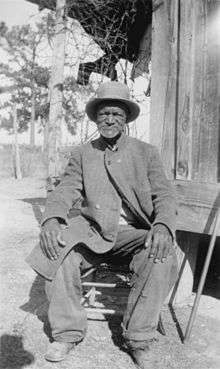Slave Narrative Collection

Slave Narratives: A Folk History of Slavery in the United States (often referred to as the WPA Slave Narrative Collection) was a massive compilation of histories by former slaves undertaken by the Federal Writers' Project of the Works Progress Administration from 1936 to 1938.[1] It was the simultaneous effort of state-level branches of FWP in seventeen states, working largely separately from each other.[2] The collections, as works of the US federal government, are in the public domain. The collection has been digitized and is available online. In addition, excerpts have been published by various publishers as printed books or on the Internet. The total collection contains more than 10,000 typed pages, representing more than 2000 interviews.[3] The Library of Congress also has a digitized collection of recordings that were sometimes made during these interviews.
Beginnings
After 1916 The Journal of Negro History published articles that in part had to do with the African-American experience of slavery (as opposed to the white view of it). This resulted in several efforts to record the remembrances of living former slaves, especially as the survivors of the generation born into slavery before Emancipation in 1865 were declining in number. The earliest of these were two projects begun in 1929, one led by Charles S. Johnson at Fisk University and the other by John B. Cade at Southern University.[1] In 1934 Lawrence D. Reddick, one of Johnson's students, proposed a federally funded project to collect narratives from former slaves through the Federal Emergency Relief Administration which was providing work opportunities for people. This program, however, did not achieve its ambitious goals. Several years passed before narratives began to be collected again.
Although some members of the Federal Writers' Project were aware of Reddick's project, the FWP slave narrative collection was more directly inspired by the collections of folklore undertaken by John Lomax. Carolyn Dillard, director of the Georgia branch of the Writers' Project, pursued the goal of collecting stories from persons in the state who had been born into slavery.[1] A parallel project was started in Florida with Lomax's participation, and the effort subsequently grew to cover all of the southern states (except Louisiana) and several northern states. In the end, Arkansas collected the highest number of slave narratives of any state.[1]
Publication
A small group of the narratives first appeared in print in a Writers' Project book, These Are Our Lives.[4] Excerpts from them were quoted in a Virginia Writers' Project book in 1940, and Benjamin Botkin's Lay My Burden Down in 1945.[2] However, large numbers of the narratives were not published until the 1970s, after civil rights activism and changing culture had created high interest in early African-American history. An anthology was published in 1998 that included audio cassettes with excerpts from the collections' recordings.[3]
Legacy
Though the collection preserved hundreds of life stories that would otherwise have been lost, later historians have agreed that, compiled as it was by primarily white interviewers, it does not represent an entirely unbiased view. John Blassingame, an influential historian of slavery, has said that the collection can present "a simplistic and distorted view of the plantation" that is too positive.[5] Blassingame's argument proved controversial; one historian in the 1990s described support for Blassingame's position as "rare," but defended him on the grounds that "all historical evidence has to be measured against a minimum standard of truth that would allow historians to use it properly. Historians have not, to date, applied this stipulation to the slave narratives."[6] Other historians worried that individuals interviewed may have modified their accounts in other ways because of being interviewed by whites.
More recently, even as the narratives have become more widely available through digital means, historians have used them for more narrow, specific kinds of studies. For instance, one historian has examined responses to conflict among the members of the Gullah community of the Low Country, with a view to relating it to traditional African ideas about restorative justice.[7] Another has drawn from them for a history of representations of the black body extending to the present.[8] Another historian has studied them against the time period of their transmission, the 1930s and the Great Depression, rather than the antebellum period they document.[9]
Though most of the narratives are preserved only in the notes of the interviewers, large numbers of photographs and tape recordings were made as well. These have proved valuable for such purposes as examining changes in African American Vernacular English over time.[10]
References
- 1 2 3 4 Yetman, Norman R (1967). "The Background of the Slave Narrative Collection". American Quarterly. 19 (3): 534–553. doi:10.2307/2711071.
- 1 2 Yetman, Norman R. (1984). "Ex-Slave Interviews and the Historiography of Slavery". American Quarterly. 36 (1): 181–210. doi:10.2307/2712724.
- 1 2 Garner, Lori Ann. "Representations of Speech in the WPA Slave Narratives of Florida and the Writings of Zora Neale Hurston". Western Folklore. 59 (3): 215–231.
- ↑ Federal Writers' Project (1939). These Are Our Lives. Chapel Hill: University of North Carolina Press.
- ↑ Blassingame, "Using the Testimony of Ex-Slaves," quoted in Yetman, Historiography, p. 186.
- ↑ Spindel, Donna J. (1996). "Assessing Memory: Twentieth-Century Slave Narratives Reconsidered". The Journal of Interdisciplinary History. 27 (2): 247–261. doi:10.2307/205156.
- ↑ Jenkins, Morris (2006). "Gullah Island Dispute Resolution: An Example of Afrocentric Restorative Justice". Journal of Black Studies. 37 (2): 299–319. doi:10.1177/0021934705277497.
- ↑ Thompson, Krista (2009). "The Sound of Light: Reflections on Art History in the Visual Culture of Hip-Hop". The Art Bulletin. 91 (4): 481–505.
- ↑ Shaw, Stephanie J. (2003). "Using the WPA Ex-Slave Narratives to Study the Impact of the Great Depression". The Journal of Southern History. 69 (3): 623–658. doi:10.2307/30040012.
- ↑ Myhill, John (1995). "The Use of Features of Present-Day AAVE in the Ex-Slave Recordings". American Speech. 70 (2): 115–147. doi:10.2307/455812.
External links
Online versions of collected narratives, by state: